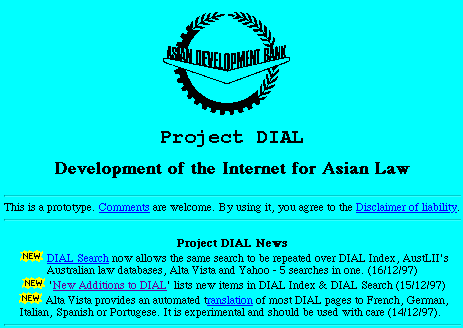[Previous]
[Next]
[Up]
[Title]
4.1. The components and approach of the DIAL prototype
A key part of Project DIAL is the development of the DIAL prototype, so
as to provide an example of the types of facilities which could be expanded
into a full system, to allow such facilities to be demonstrated to potential
users and potential funding sources, and to allow users to test the facilities
for themselves. It was decided at the outset of the project that, given that
the World-Wide-Web made this possible, the prototype would be accessible by the
public from its earliest stages, except for the DIALogue component which is of
its nature only available to Authorised Users.
The prototype has been available for public access since August 1997 at http://www.austlii.edu.au/au/special/dial/
There are some disadvantages in allowing users to access a prototype before it
is finished, but it has allowed quite a number of people to become aware of and
interested in Project DIAL even before the prototype is complete.
Whether and how the Project DIAL prototype is advanced to any further stages
beyond the completion of this feasibility study is a matter for the Asian
Development Bank.
The three components of DIAL can be seen from its home page:
- DIAL Index - An intellectual index (or catalogue) of law sites on
the World-Wide-Web with an emphasis on legislation-related materials and
development law subject matter; Some of the entries in DIAL Index are embedded
searches of the DIAL Search facility;
- DIAL Search - A search engine searching every word found on high
value legislation-related sites across the Internet, using an index created by
a web spider; DIAL Index is used to `target' the web spider; and
- DIALogue - A communications facility between Authorised Users
(primarily DMC officials) and Panelists with wide experience in development
law.
Each of these components is described in detail in the next three
chapters. This chapter discusses a number of issues common to the first two
components.
A broad analogy to these components is that DIAL Index is like looking through
a library card catalogue and picking general titles (ie. Internet sites) that
might be useful; DIAL Search is like going to the actual book and viewing the
text (ie. searching full-text legislation for word occurrences); and DIALogue
is like getting general guidance from the local reference librarian.
This analogy is appealing but has two fundamental limitations. First, full text
searching (such as in DIAL Search) does not really have a paper analogy - our
experience of reading books rarely involves us scanning large bodies of text
for pre-defined word combination, it is closer to a very limited form of
hypertext browsing.
More important, if you only implement digital facilities in ways that have
paper-based analogies, you are a priori accepting potentially crippling
limitations on a new and different medium. One of the aims of developing
computerised facilities is to achieve things that are simply impossible in a
paper-based system (for example, the searches of DIAL Search embedded in DIAL
Index). Analogies to paper-based systems can be very useful in achieving user
familiarity and acceptance in a new medium, but they should not be used as a
limiting factor.


Project DIAL home page - http://www.austlii.edu.au/au/special/dial/
Some of the factors underlying the approach taken in the DIAL prototype, and
which will be discussed in the following chapters, are:
- An attempt to address some of the weaknesses of existing access tools (as
discussed in Chapter 2).
- Integration of an intellectual index, embedded searches, web spider and
search engine so that each interacts with the others in as valuable a way as
possible.
- The intellectual index as one `virtual view' into a larger index that
supports numerous legal indexing projects.
- Design of web pages to assist maximum effectiveness of access by those
with low grade Internet connectivity.
- A structure to support long-term collaborative indexing and multi-lingual
indexing.
- A web spider targeted by an intellectual index, to allow both
comprehensive indexing of high value law sites and selectivity of sites indexed.
- Search facilities over sites indexed by the web spider that allow a high
degree of selective searching by limiting the scope of searches in various
ways.
[Previous]
[Next]
[Up]
[Title]


